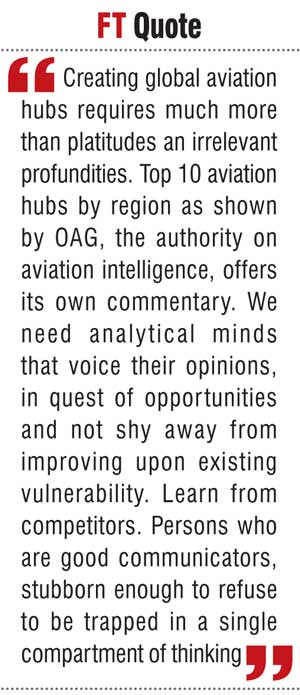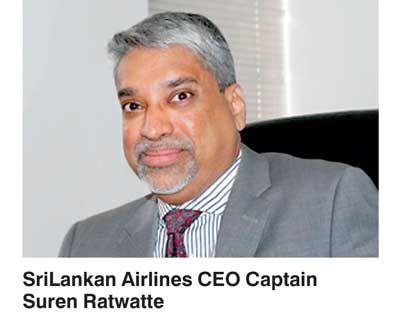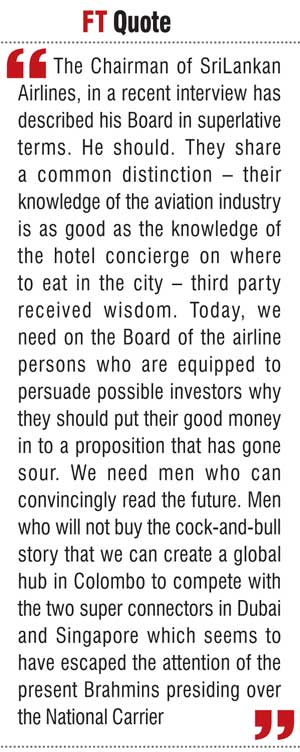Wednesday Dec 31, 2025
Wednesday Dec 31, 2025
Wednesday, 14 September 2016 00:01 - - {{hitsCtrl.values.hits}}
Ten Expressions of Interest (EOIs) have been received for SriLankan Airlines, which will be whittled down in the coming months before the Government begins official talks to enter in to a Public-Private Partnership with an international company, a top official said, but a debt-sharing agreement appears unlikely – Daily FT news report,
7 September
It is not enough to say that our airline can accesses a market of 250 million in the four states in South India. How will you do it? It is easier said than done
Most airlines lose money. The state-owned beasts among them lose more. Quite apart from its accumulated losses of nearly Rs. 107 billion, there is something else that is wrong with SriLankan Airlines.
Successive regimes have resorted to offer a seat on the Board of the National Carrier to a very special type of people. They come from the entitlement class. Those selected are the cognoscenti drawn from the corporate world who have access to the sanctum sanctorum of, to follow the genesis in order, Ward Place, St. Sebastian in Hulftsdorp, Rosmead Place and Fifth Avenue.
There was an implicit aura of glamour associated with the particular assignment. The ability to fly to distant places after a board meeting or a game of golf is an exotic experience not to mention the fun of eating out of season fruit and washing it down with champagne – that Charles Dickens described as elegant extras of life.
The map that shows the 10 top hubs by region says it all. But as the Cheshire cat told Alice, if you do not know where you wish to go, does it matter which direction you go?
SriLankan appointments
President Premadasa put his son-in-law on the Board. President Rajapaksa made his brother-in-law the Chairman. President Chandrika Kumaratunge before she took the sensible decision to hand over the management to Emirates, chose a family confidante who was clever and crafty to convert the pull and prestige of her mother Sirimavo Bandaranaike among nonaligned tea-drinking Arabs into a ‘Hotsy Totsy’ fortune, acquiring in the process the reputation of a business genius.
The present ‘Yahapalana’ Prime Minister seems to have followed the precedent and offered the bounty and bonanza to buddies. Its present composition is eloquent testimony.
Except for two, the son of a former Secretary to a former President, and another whose allegiance is ditto to the same President, all others are Royal College buddies of the Prime Minister. They have a common denominator. They all have abiding interests, professional or private, beyond the shores of Sri Lanka. A seat on the Board of the airline is ‘open sesame’ to the cave of unlimited travel just as in ‘Arabian Nights.’
The Chairman of SriLankan Airlines, in a recent interview has described his Board in superlative terms. He should. They share a common distinction – their knowledge of the aviation industry is as good as the knowledge of the hotel concierge on where to eat in  the city – third party received wisdom.
the city – third party received wisdom.
Today, we need on the Board of the airline persons who are equipped to persuade possible investors why they should put their good money in to a proposition that has gone sour. We need men who can convincingly read the future. Men who will not buy the cock-and-bull story that we can create a global hub in Colombo to compete with the two super connectors in Dubai and Singapore which seems to have escaped the attention of the present Brahmins presiding over the National Carrier.
Creating global aviation hubs
Creating global aviation hubs requires much more than platitudes an irrelevant profundities. Top 10 aviation hubs by region as shown by OAG, the authority on aviation intelligence, offers its own
commentary.
We need analytical minds that voice their opinions, in quest of opportunities and not shy away from improving upon existing vulnerability. Learn from competitors. Persons who are good communicators, stubborn enough to refuse to be trapped in a single compartment of
thinking.
If the technocrat Prime Minster is honestly committed to privatise or to ‘reorient’ the bankrupt National Carrier, he should immediately appoint three persons that this writer is impudent enough to recommend. None of them are personally known to this writer except a fleeting encounter with one of them.
The first nominee to the board of the self-asphyxiating airline is Professor Razeen Sally, the new Head of the Institute of Policy Studies. He has forcefully argued that ‘plugging to India will bring shared befits to all of South Asia’. He has been reiterating the theme, long before the lead manager of the reorienting exercise makes his Sri Lankan clumsy discovery in the document soliciting Expressions of Interest from potential partners for SriLankan Airlines.
The second nominee to the board is Professor Rohan Samarajiva. In the 2nd BIMSTEC [Bengal Initiative for Multi-Sectoral Technical and Economic Cooperation] Foundation Lecture at the Chulalongkorn University, he has unmistakably identified the geo economic opportunities in the Bay of Bengal.
The third nominee to the Board of SriLankan Airlines which relies on a pathetic piece of paper from its auditors to label it as a ‘going concern’ is Anushka Wijesinha, Chief Economist of the Ceylon Chamber of Commerce. In a contribution to the ‘Diplomat’ he has convincingly argued that Sri Lanka is at the door step of a dynamic market, India, but the location is lost without openness.’
The Chief Executive Officer of the airline is the brother of Charitha Ratwatte, an advisor of the Prime Minister. The Chief Commercial Officer is a protégé of R. Paskaralingam, another Advisor of the Prime Minister. The contents of the document prepared to solicit expressions of interest from possible partners for Public Private Partnership of SriLankan Airlines tell us that they are all cruising close to ‘fantasy sphere’ higher than the troposphere where all weather takes form.
If SriLankan Airlines [and its appendage Mihin Lanka] are in crisis, the Board of Directors, the CEO and the CCO are not aware of it. If indeed they are, the signs indicate that they are in no hurry to resolve it.
 ‘Reorienting’ the National Carrier
‘Reorienting’ the National Carrier
It now appears that the lead manager entrusted with the task of soliciting possible partners to ‘reorient’ the National Carrier has not been briefed adequately to prepare a convincing document that holds even a glimmer of an idea to resuscitate the airline with accumulated losses of Rs. 64.92 billion as at 31 March.
The document designed to seek serious partners for SriLankan Airlines makes three principal assertions.
1. Sri Lanka is strategically located at the epicentre of global aviation growth. The island nation is in an ideal location for an intercontinental hub – where 85% of the world’s population can be reached within 10 hours from Colombo, with more than 2b people living within a narrow-body flight range from BIA.
2. The four southern states of India are located closer to Colombo than to Delhi. Colombo can therefore be used as an efficient gateway to the South Indian market, giving it access to 250 million people.
3. Colombo can potentially become a powerful alternative hub to the three main Gulf hubs (Dubai, Abu-Dhabi and Doha).
Geography is constant. Human imagination that fuels human endeavour is not. This writer is baffled as to why Captain Suren Ratwatte, the Chief Executive Officer, or Siva Ramachandran, whose proven expertise in aviation-related matters is not in doubt,  has not advised the lead manager of the transaction of the demonstrated wisdom of Emirates Airlines.
has not advised the lead manager of the transaction of the demonstrated wisdom of Emirates Airlines.
A few years back, Sheik Ahmed bin Saeed Al Maktoum, Chairman of Emirates, in an interview with the ‘Economist’ traced a new silk road. “Nearly two billion people live within four hours’ flying time of the Gulf and twice as many within seven hours. Since the arrival of ultra-long-range airliners in the mid-1990s in the shape of the Boeing 777, any two big cities on Earth can be linked via Dubai with no other stops.”
The map that shows the 10 top hubs by region says it all. But as the Cheshire cat told Alice, if you do not know where you wish to go, does it matter which direction you go?
Accessing South India
It is not enough to say that our airline can accesses a market of 250 million in the four states in South India. How will you do it? It is easier said than done. First the conducive political climate has to be created. The privatisation document makes no reference to the new civil aviation policy of India that was announced a few weeks ago.
India has drastically changed its civil aviation policy. It will enter in to ‘Open Skies’ air services agreements on a reciprocal basis  with SAARC countries and countries located beyond 5,000 km from Delhi.
with SAARC countries and countries located beyond 5,000 km from Delhi.
Indian civil aviation policy planners have concluded that India’s 350 million strong middle class only flies once in four years. To encourage their travel, the Government will develop 350 unused airstrips and airports. The Indians have woken up to Asia and the Indian Ocean.
Indians plan to have several aviation hubs. It will be one of three top aviation markets by 2020. Passenger traffic at airports are expected to reach 450 million from what now hovers around 180 million as has been announced by an Indian Aviation Ministry official who spoke at the recent unveiling of revised civil aviation policy.
The Indian Civil Aviation Policy document of 2016 is essential reading for Eran Wickramaratne, the only voice of sanity that this writer has found in the present cabal of economic wizards parading in the present firmament.
The Indian Government has proposed to take flying to the masses by making it affordable and convenient. For example, if every Indian in middle class income bracket takes just one flight in a year, it would result in a sale of 350 million from the present 70 million tickets. To make it possible, the Government hopes to bring down air fares, especially on regional routes, to an affordable level.
Blatant balderdash
Our pundits claim that Sri Lanka is the epicentre of global aviation. That is blatant balderdash. Sri Lanka has a window of opportunity. There are many smart cities emerging in the south of the subcontinent. My advice to Captain Suren Ratwatte and Siva Ramachandran is to explore the possibility of locating a partner with whom SriLankan can mount single aisle operations from Colombo to Kochi and Kozhikode in Kerala, Mysuru and Hubli Dharwad in Karnataka, Vijayawada and Vishakhapatnam in Andhra Pradesh, Warangal in Telangana, Madurai and Coimbatore in Tamil Nadu.
They are the fastest growing urban wealth creation centres in South India. They are the secondary airports that could feed a modest international airline operating out of Colombo sandwiched between two global super connectors Dubai and Singapore.
The accompanying map of the top global aviation hubs has a narrative of its own. The word ‘crisis’ when written in Chinese is composed of two characters. One denotes danger and the other implies opportunity. This is a truism that can be used either to seduce the regular idiots or to really get on with the job of containing, managing and mastering the crisis with a positive outcome.
Just as I reach the end of this missive at 10 p.m. on Tuesday 6 September, I can see Parliamentarian Bimal Rathnayake asking as to who gave permission to the Indians to carry out a feasibility study on the upgrading of the Palaly Airport. The Prime Minister informs him that the Government did.
Across the Hanuman Bridge another story unfolds. The Indians under Narendra Modi have got down to business. They see nations in pursuit of economic growth, stability, social order and cohesion. They call it the Phoenix Horizon. The Indian Minister of State for External Affairs switches from Valmiki to Homer. Asia is the daughter of Oceanus and wife of Prometheus, the god of forethought who gifted fire to man.